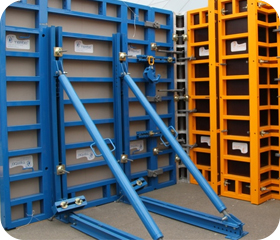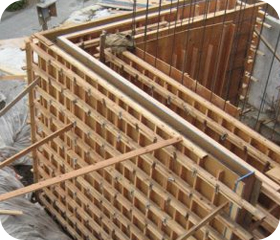Why use formwork release agent?
The main function of the formwork lubricant is to reduce the adhesion between the formwork elements and the concrete mix, creating a protective film on the inner surface of the structure. In general, the use of lubricants for formwork will help us avoid many problems that may arise during monolithic construction. Let's study them in more detail.
When carrying out monolithic works, we need the solution to completely fill the mold and not form voids. For small structures, simple methods are used, such as tapping the formwork from all sides or shoveling mortar with a shovel. In industrial construction, special vibrating equipment is used, thanks to which air is removed from the concrete mixture and it becomes more dense and durable. So, when compacting the mortar, it fits snugly to the inside of the formwork, which complicates its subsequent dismantling.
When disassembling the formwork, there is a high probability of damaging not only the formwork panels, but also the concrete structure itself. Now formwork systems are increasingly used, which consist mainly of metal structures and plastic shields, concrete does not stick to these materials as much as to wood, but metal is susceptible to corrosion, the use of formwork lubricant will help to avoid it.



And what properties should formwork lubricants have? To begin with, such a mixture should be chemically neutral to both concrete mixtures and formwork elements. Further, the lubricant must have sufficient viscosity, which allows it to be tightly held on both horizontal and vertical structures, even at elevated temperatures and under conditions of technological steaming. Of course, the lubricant should not leave stains and streaks on concrete products, so as not to complicate the finishing. And safety, of course. The composition should not contain substances harmful to human health.
The application of formwork lubricant is carried out on the inner surface of the formwork panels after fastening them together with screw pairs or spring clamps and immediately before pouring the concrete mixture.
As for the lubricant consumption for the formwork, it varies depending on the type and quality of the application surface. Having considered all types of lubricants, we know that 1 liter of lubricant is enough for 10-20 m2 of surface.
Please note that the consumption on wooden surfaces is higher than on metal and plastic surfaces.
Having studied all these factors, a special lubricant for molds and formwork "Monolith" was developed, which is a modified mixture of solvent-free oils and is safe for human health.
It is suitable for use on any type of surface, completely eliminates the adhesion of the surface of the product and the shape. This lubricant does not leave any traces on the finished products, does not spoil their appearance even when the molds are heated to 80C. Unlike analogues, the lubricant for molds and formwork "Monolith" has a low consumption (1 liter per 20-40 m2 on a wooden and 65-80 m2 on a plastic or metal surface), and a favorable cost. It can be applied to the surface either with automatic sprayers or manually using a roller, brush or brush.
Remember that the use of lubricant will not only prolong the life of any type of formwork, but also prevent the destruction of ready-made structures during dismantling.
Additional products
 Shower drain CLASSIC BLACK 60 cm, horizontal, rain grate, black + hygienic shower AS A GIFT
Shower drain CLASSIC BLACK 60 cm, horizontal, rain grate, black + hygienic shower AS A GIFT

